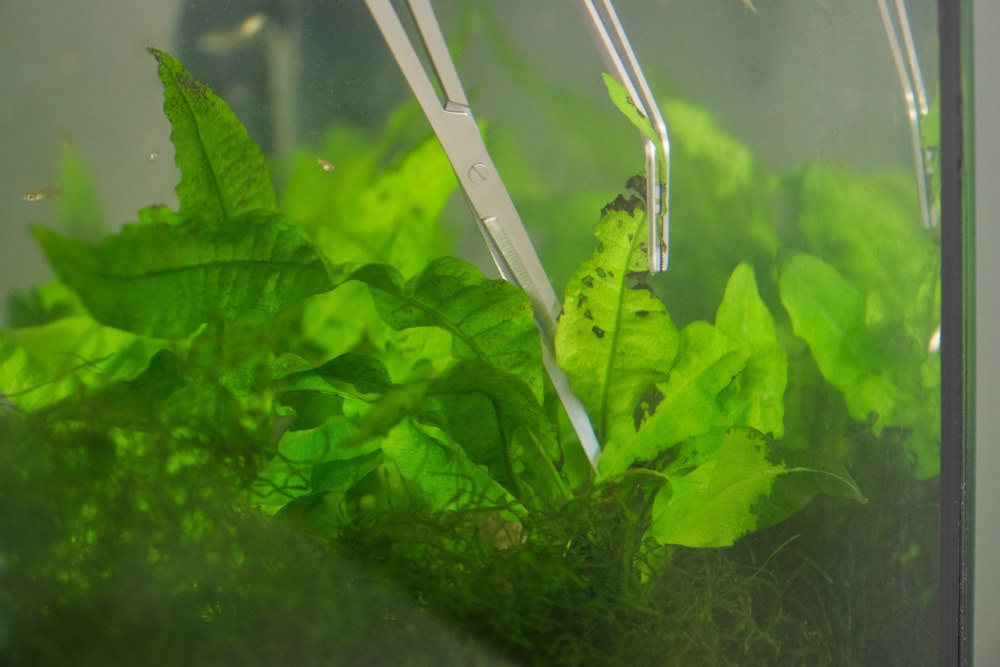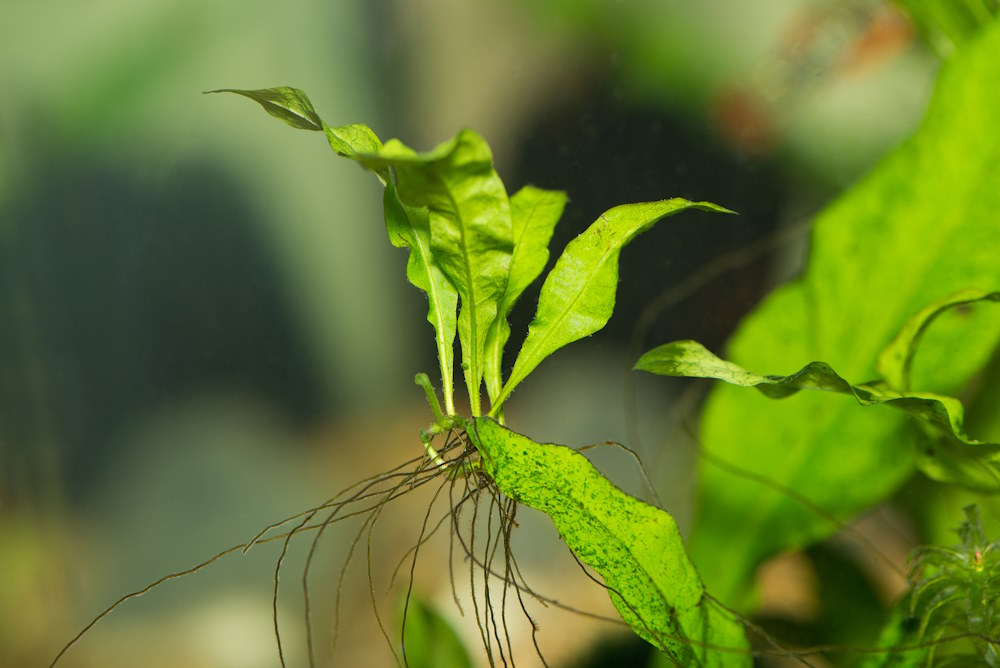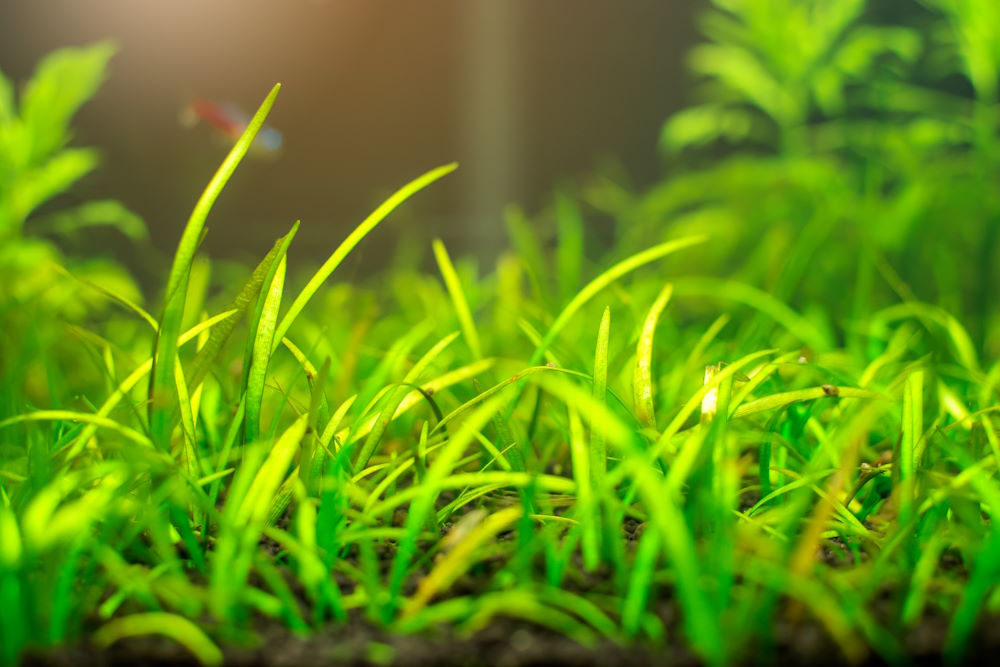Why Do Aquarium Plants Melt? 7 Reasons for Dying, Melting Leaves
If you add a new aquarium plant to your tank, it may look great for a couple weeks, but then it starts losing some leaves or just looks like it’s dying back in general. Don’t give up! It is common for aquarium plants to change and adapt when they experience a disruption in growing conditions. Learn about 7 reasons why this may happen and what you can do to give your plants the best chance to grow to their fullest potential.
1. You just got a brand-new plant from the store or online and added it to your aquarium.
Many plant farms actually grow aquarium plants out of water or emersed. This is for a few reasons — the plants grow faster out of water, tend to ship better, and can be kept free of algae. However, when you buy an emersed-grown plant and put it in your aquarium, the plant must then transition into a submersed-grown (or fully underwater) plant. The emersed-grown leaves are used to taking light and CO2 from the air, so once the plant is kept submerged underwater, it has to adapt and grow new leaves that are capable of taking in CO2 and nutrients from the water. When this happens, the emersed-grown leaves die off completely and the plant may appear to be “melting.”
Over time, the plant will regrow but may look a bit different than before as it takes on its underwater form. All the thick, broad, emersed leaves melt away, and smaller, thinner, submersed leaves will replace them. As long as it has healthy roots and is not moved once planted, you should see little shoots popping up within a few weeks. Also, it doesn’t hurt to remove leaves that are clearly melting. Simply cut off the dying leaf at the base of the stem or near the substrate. Rotting leaves can sometimes cause nitrogen spikes or algae growth, so it’s common to remove them unless your clean-up crew members consume the dead leaf first.

Trimming browning leaves on a Java fern plant
2. A plant that has already been growing in an aquarium experiences a change in water parameters.
It is normal for plants to melt or experience browning of leaves when they undergo an environmental change, such as moving from one aquarium to another or from your local fish store’s tank to your home tank. Altering the water parameters drastically in the same tank can also cause a similar effect. You may experience melting if you suddenly increase or decrease your fertilizer dosing, add CO2 gas, interrupt your normal water change schedule, or make lighting changes. Even temperature changes like rising heat in the summer can alter the regularity of the aquarium ecosystem. Cryptocoryne plants (or “crypts”) are particularly susceptible to both the first and second types of melting, which is why hobbyists refer to as crypt melt.
The remedy in this situation is to simply give the plant time to adapt and regrow by giving it stable water conditions and plenty of nutrients. You can either prune the leaves one by one as they melt or trim them down all at once so the plant can focus on new growth. Keep the aquarium environment as stable as possible, and wait several weeks for the plant to come back.

When a Java fern leaf is growing a new baby plant, the mother leaf will eventually die off.
3. The plant is planted the wrong way in the aquarium.
Each aquarium plant has slightly different needs in terms of planting, so understanding your plant’s individual needs is key. Planting a plant incorrectly can cause it to suffer and cost valuable time and money to replace if it doesn’t make it.
If your plant is a bulb plant such as a lily, lotus, or crinum, it’s best to simply place the bulb on top of or partially buried in the substrate. The roots will naturally grow downward if planted this way, but if buried completely, the bulb will likely suffer as it needs to be exposed to grow properly. Rhizome plants such as Java fern, Anubias, and Bucephalandra need to have their rhizome (i.e., the horizontal “trunk” or thick stem from which roots and leaves grow out of) exposed and not buried in substrate. It is easiest to attach these plants to decor such as wood or rock, but if you want it growing in substrate, only cover the roots and leave the rhizome exposed as much as possible.
Stem plants such as bacopa, pearl weed, and Pogostemon stellatus do like to be buried deeply into the substrate. Rosette plants such as Amazon swords and cryptocoryne plants need to have their roots buried in substrate while the crown (or base of the leaves) is above ground. All these differences may seem small but can actually have a big impact on how your plant grows and looks in the long term. Read our quick guide to planting aquarium plants to make sure they get planted the right way in your fish tank.
4. Plants do not have enough access to nutrients or light in the aquarium.
Another reason why plants may shed leaves or appear to be melting back may be because they don’t have all the necessary elements to grow. For example, too little light or nutrients can cause leaves to yellow and die off. This is the plant's way of consuming its older leaves to continue surviving in less-than-optimal conditions. If you notice your plant is struggling to grow, pale in color, or losing leaves one after another, consider regularly dosing with Easy Green all-in-one liquid fertilizer to give the plant plenty of nutrients to grow new leaves. It comes with a pump or drop cap so you can easily add the right amount of fertilizer to your planted tank. If you have rooted plant such as crypts, swords or bulb plants, using a nutrient-rich aqua soil or a substrate supplement like Easy Root Tabs can be a great option to provide even more nutrients for heavy root-feeding plants.
Additionally, even if your plants are receiving adequate nutrients, they may be lacking proper light for their growth needs, which would cause your plant to shed leaves or melt back. For example, this can happen to smaller plants that are overshadowed by other larger plants in a big tank. Giving the larger, bushy plants a trim can allow more light to reach all the plants in the tank. If your aquarium is a little dark, consider a light designed for plant growth like the Easy Plant LED. It is a great option to boost plant growth and reduce melting if they are not currently receiving enough light from a standard aquarium hood light. Adequate lighting and nutrients are crucial for growing robust, healthy plants.
Consider the needs of the plant you are trying to grow as well. Different aquarium plants in the trade will naturally require different parameters to grow to their fullest potential. Highly demanding or “difficult” plants will need CO2, plenty of nutrients, and very bright lighting to thrive. If you place a plant like that into a low tech tank with dimmer lighting and no CO2, it will likely melt away and die off. Setting yourself up for success by learning the needs of your plants will save time, stress, and money in the long run.

Carpeting plant receiving bright, direct sunlight
5. The plant experienced temperature extremes during shipping.
If you ordered your plants online and they were shipped to you, it is possible that they experienced damage during the shipping process that can cause the plant to melt after you put it in your aquarium. It might not be apparent at first, but if the plant accidentally froze in its package, it may lose all its leaves or die off completely once placed underwater. If this happens and you purchased your plant from Aquarium Co-Op, send an email to our Customer Service team and we’ll be happy to take care of you.
6. A bulb plant may not grow if it is a dud.
A percentage of dry bulb plants, like dwarf aquarium lilies, sometimes are not viable and the bulb will never grow into a plant. If it has been many weeks since adding a new bulb to your tank and you still don't see any signs of growth, it is likely that the bulb is a dud and you should reach out to the seller for a replacement. To mitigate this risk, Aquarium Co-Op offers potted bulb plants that are already sprouted with leaves and roots, ready to plant in your aquarium.
7. Anubias rot can affect the rhizome in Anubias plants.
Lastly, a rare disease called Anubias rot can affect Anubias plants where the rhizome of the plant becomes mushy and breaks down. This pathogen is difficult to control and may end up consuming the entire plant over time. Unfortunately, there is no easy way to save the plant except to cut off the affected parts and see if the rest of the plant recovers. This condition can happen at the farm, in our care, during transit, or during planting. With no specific cause or source to blame, we offer a refund or a reship of Anubias when this happens. Contact our Customer Support so they can help you troubleshoot the issue.
The best way to set your aquarium plants up for success is to provide them all the necessary elements they need to grow. Fertilizers designed for plant growth are an easy way to make sure your plants have the nutrient building blocks they need to adapt to your aquarium and thrive — especially in times where your plant may be experiencing a melting phase. For a complete list and more information on different types of plant fertilizers and how to use them, check out this article.




